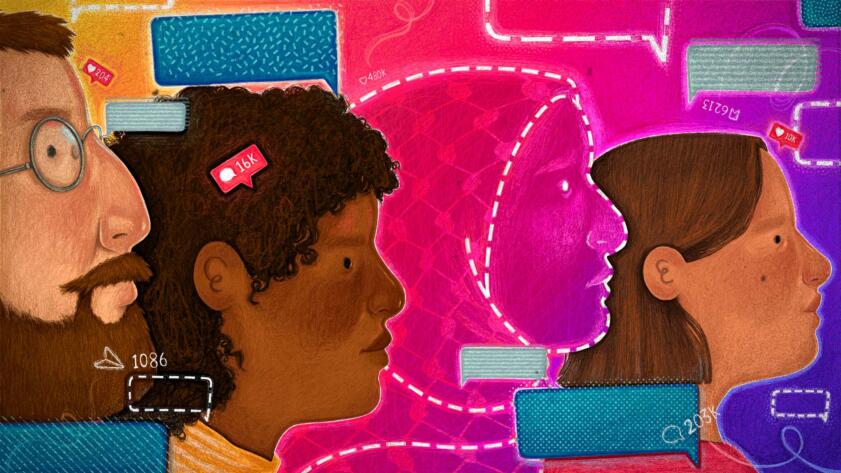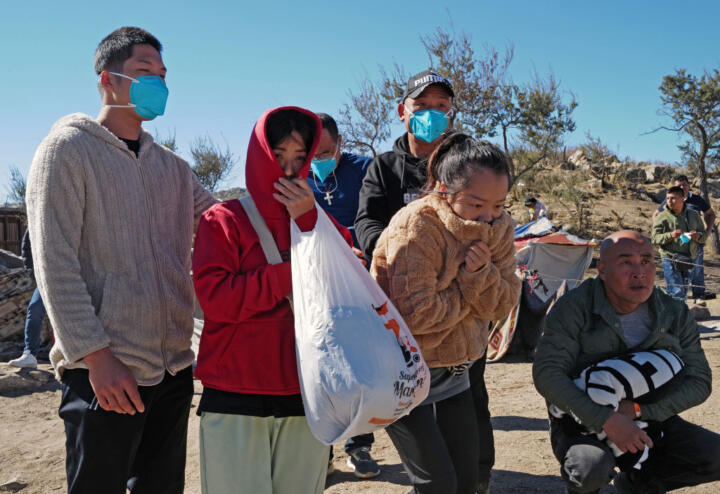The Markup, now a part of CalMatters, uses investigative reporting, data analysis, and software engineering to challenge technology to serve the public good. Sign up for Klaxon, a newsletter that delivers our stories and tools directly to your inbox.
This article is copublished with Documented, a multilingual news site about immigrants in New York, and The Guardian US, which covers American and international news for an online, global audience.
Xiong couldn’t pinpoint exactly what finally prompted him to leave his hometown in China, the only place he’s lived for 32 years, and embark on the arduous journey on foot through Central and South America to reach the United States in 2023. However, he clearly remembered the catalyst that ignited the idea.
It was a video on Douyin, the original, Chinese version of TikTok created by ByteDance.
One day in January 2023, shortly after China announced a wide-scale easing of COVID-19 quarantine rules, Xiong, whose full name we are withholding because of the risk of negative consequences for his family in China, was browsing videos on Douyin as a way to pass the time after a long day of work. That evening, he stumbled upon a video unlike any he had seen before: A Chinese family of three was crossing the Darien Gap, a treacherous passageway between Colombia and Panama consisting of a terrain that ranges from wet marshland to mountainous jungle. The young parents and their son, who seemed no older than 10, trudged through a muddy path, tangled with tree branches and surrounded by dense woods. The place looked undeveloped, and wild, very different from the suburbs of Wuhan where Xiong grew up.
The account that posted the video is called “一家三口闯美记,” which translates to “A Family of Three’s Adventures in America.” Curious, Xiong went to the account page and found more videos of the family trekking through mountains, rivers, and some villages — all places he had never heard of. He felt amazed, but more so, he felt curious about this family.

Hello World
‘Every Day That I Don’t Get My TikTok Account Back Is An Opportunity That’s Lost’
How arbitrary account bans affect the livelihoods of creators with disabilities
These scenes stood in stark contrast to Xiong’s life. Through much of his adulthood, he’s felt powerless. His job as a garment factory worker, and later as a pharmacy store worker, was repetitive and he had no prospects of moving up to another job. His family struggled to accept his homosexuality, constantly introducing him to women they wanted him to marry. During the COVID-19 pandemic, strict quarantine measures in Wuhan left him confined to his apartment building. In every aspect of his life — his work, his family and even his neighborhood — he felt trapped.
“Is there any way for me to live a more desirable life?” Xiong, 33, pondered this question, but couldn’t find any satisfying answers until he watched the family of three’s videos on Douyin. From there, he binged video after video from the family’s account, and soon, the app started feeding Xiong videos of other people walking to the United States. He gradually learned that this method of traveling to the United States was called “walk the line,” according to a growing collection of videos on the app.
In contrast to TikTok, Douyin faces stricter content control regulations imposed by the Chinese government due to its operation within China. Video related to topics considered sensitive or inflammatory by the government is removed from the platform. Several Chinese migrants told Documented that the migration-related content in Chinese, previously accessible on Douyin and provided guidance for their journey to the U.S., has disappeared.
Content creators on Douyin, TikTok, YouTube and others, have taken the DIY ethos of those platforms to explain step-by-step how to migrate to the United States through Latin America. They share this information in Chinese, Spanish and languages spoken in West African countries, allowing for migrants to more confidently navigate the dangerous path north. While many still use people smugglers, who also use those platforms to advertise, the cheap and addicting social media content has enabled migrants to bypass parts of the traditional route north and even created “migration influencers” who continue to post to their sizable following after they arrive in the United States. This method of flying to Latin America and walking to the United States, is used by immigrants who cannot come to the U.S. through a normal visa process. The family of three is just one of over 20,000 who have taken this approach to enter the United States in 2023.
According to federal data, the number of Chinese people arrested by the U.S. Customs and Border Protection for illegally crossing the border from Mexico has increased by more than 5,000% in the past two years, from 450 arrests in fiscal year 2021 to 24,314 in fiscal year 2023.
These platforms provide users with actionable information, but they only focus on making the journey palatable, they don’t mention the challenges involved in starting a new life in the U.S. and navigating the bureaucracy of the country’s immigration system.
Xiong was attracted to the new life that the family started in Los Angeles. In one video, Xiong saw tall palm trees under the blue sky and white clouds. There were people leisurely sunbathing on the beach. In another video, he saw fighter jets crossing the sky at an airshow, as crowds of people watched them with admiration.
The life of this family in the U.S. appeared colorful and full of new experiences. They tried shooting at the shooting range, went on road trips, and watched local cultural performances. After watching these videos, Xiong felt a long-lost excitement. It was as if he, a man long trapped at the bottom of a well, had been thrown a lifeline to the outside world by the Douyin videos, he said. And so he decided to follow in their footsteps, leave his hometown and make the thousands of miles long journey to New York City. He heard from other Chinese migrants who arrived in the U.S. earlier that NYC had a better public transit system and was more convenient for someone without a car.
Thousands of people have watched videos of “A Family of Three’s Adventures in America.” And thousands of them, like Xiong, may have followed their path to come to the U.S. after watching the videos posted by vloggers like the family of three.
For Xiong, Douyin was essential for his seven-week-long journey from Wuhan to New York City where he first tried to start a new life in the U.S. However, as Xiong arrived in the United States, he quickly realized that the real challenge had just begun. While the videos provided guidance on reaching the U.S., they offered little insight into navigating life in a foreign country without social networks or language skills.
A Journey Pieced Together Through Clues On Social Media
Once the idea was planted in his mind, Xiong spent several months researching how to “walk the line” on the internet and through Douyin videos and comments. He searched for information and keywords from various videos to assemble a rudimentary map of the route and even obtained two free comprehensive PDF guides that detailed many legs of the journey. These guides included practical tips such as clearing chat and browsing history on travelers’ phones before departing China to reduce the risks of being stopped at the airport by customs officers or discreetly placing a $20 bill in your passport to bribe law enforcement officers when traveling from the city of Ipiales to Medellin in Colombia.
Through comments on Douyin, he read about the dangers other people had experienced or heard about on their journey to the U.S., including thefts, robberies, and even deaths. He joined some Douyin groups consisting of people interested in walking the line to the U.S. and those involved in the related immigration industry, and later transitioned to other chat groups on WeChat and WhatsApp.

Automated Censorship
Demoted, Deleted, and Denied: There’s More Than Just Shadowbanning on Instagram
An investigation by The Markup found that the platform demoted images of the Israel–Hamas war, deleted captions without warning, and denied users the option to appeal
Xiong attempted to apply for a tourist visa to the United States but was rejected twice. This strengthened his determination to go abroad. “It feels like being trapped in a cage. Every time I’m rejected, the more I want to break free,” Xiong recalled. At this point, “walking the line” seemed to be his only choice to come to the United States.
Over the course of several months, Xiong pieced together the information he collected like a puzzle. Previously unfamiliar place names gradually became clear in his mind: thanks to social media posts and messages from dozens of migrants, he had a roadmap for his entire journey from China to Mexico.
Plan in hand and carrying only a backpack with a set of clothes and dry food, he hopped on a train from Wuhan to Guangzhou one warm evening in September 2023. He left without saying a word to his family worrying that they would try to stop him. He was stopped by Chinese customs officers at the Guangzhou Baiyun International Airport. Undeterred, he arranged for flight tickets to Chengdu and then onward to Urumqi. After navigating his exit from China, he made stops in Kazakhstan, Turkey, and Panama before finally reaching Ecuador.
“I feel quite bitter when I look back,” Xiong said. Then he paused, tears in his eyes. What he had seen in Wang’s videos, the joyful and adventurous journey, did not match the reality of his experiences. Every time Xiong entered a new country, he found himself in a new, dangerous situation. In Colombia, local taxi drivers attempted to extort him and the other migrants he was traveling with, by threatening to send them to immigration authorities. In Tapachula, Mexico, a fellow migrant’s phone was stolen by locals. Upon arriving in Mexico City, just as the journey seemed to be ending, he was discovered by police and deported back to Tapachula. It took him another 15 days to travel back to Tijuana.
Xiong also remembers his fellow compatriots and asylum seekers from South America who lent him a helping hand along the way. Prior to departing from China, he had downloaded two guides on walking the line, crafted by Chinese migrants who had taken the route to the U.S. earlier. Although these guides meticulously outlined each step of the journey, Xiong never actually referred to them during his travels. The circumstances along the journey kept changing: what might have been a viable route one day could be obstructed by local authorities the next. Upon arriving in Turkey before his flight to Ecuador, Xiong relied on real-time updates from chat groups on WhatsApp and WeChat.
During the journey, Xiong joined the groups of asylum seekers from South America. Their route was more perilous than that of most Chinese migrants, but it was also more affordable. Xiong remembered the relief he felt when he finally saw the high walls at the border. “I thought: The journey is over.”
Forty-nine days after leaving his hometown, Xiong arrived in Tijuana at the U.S.-Mexico border. There, he crossed the border and surrendered himself to border patrol agents. Two days later, upon being released from immigration detention, he boarded a flight from San Diego to New York City. He eventually settled down in Flushing, a destination favored by many Chinese immigrants who entered the United States through “walking the line.”
While many people on social media make the journey feel romantic and adventurous, the migrant path between Latin America and the United States is one of the most dangerous routes in the world. According to the International Organization for Migration (IOM), the Mexico-U.S. border has the highest number of deaths among all land migration routes globally. In 2022, a total of 686 migrants died or went missing in the border region. On March 29th, eight bodies were found on a beach in the town of Playa Vicente in Mexico. The victims were later identified as Chinese migrants who took a similar route as Xiong, attempting to cross the border to reach Oaxaca, and then continuing northward by land to enter the United States.
Influencers play a significant part in shaping people’s information sources, regardless of their political ideology or geographic location, said Josephine Lukito, an Assistant Professor at the University of Texas at Austin’s School of Journalism and Media. Lukito studies political mis- and disinformation, and her work especially focuses on interactions between news and social media platforms. She has significant concerns about social media leading people to “fall down the rabbit hole”, as individuals tend to seek out content that further entrenches them in their existing beliefs.
The homogeneous content frequently suggested by Douyin’s algorithm not only reinforces people’s aspirations to move to the U.S. but also gives them practical advice. While it’s unclear how many people migrated because of videos on Douyin, there are some clues in the comments of “walk the line” videos.
Yang Wang is one of the vloggers who used to post a lot about “walking the line” on a now-deleted account called “Yang Wang Riding the Motorcycle.” In one of Wang’s most recent videos he posted from a new account called “Yang Wang,” he commemorates the first anniversary of his arrival in the U.S. In the video’s comments section, Chinese asylum seekers thanked him for inspiring them to go to the U.S.
“I decided to come to the U.S. after watching your video, Brother Yang,” one Douyin user said in the comments.
“Inspired by you, I’m now in Flushing,” another user commented.
America, The Not-So-Great
Upon arriving in Flushing, Xiong was disappointed with what he saw. In the Douyin videos he watched, New York featured high-rise buildings and dazzling billboards of Times Square. But all Xiong saw in Flushing were Chinese signs, street vendors and unadorned shops, reminiscent of his hometown in the 1990s. “Flushing looks like a third or fourth-tier small city in China,” Xiong said. He realized that not all parts of New York were as glamorous as Times Square in Manhattan.
Xiong had heard many vloggers discuss the challenges they faced as Chinese asylum seekers in New York City, but the reality was even harsher than anticipated. The intense competition among Chinese asylum seekers for jobs and apartments was daunting — Flushing had seen a wave of migrants arrive in the past two years and opportunities for newly arrived migrants from China were scarce. Xiong shared a two-bedroom apartment with three others, and paying rent quickly depleted his savings as he waited for a work permit. Xiong heard another asylum seeker describe being in an even worse situation: 11 people squeezed into a two-bedroom.
Finding work was equally hard. It took Xiong three weeks to find one paid gig. He worked at a kitchen cabinet company where he carried heavy objects, working from 8:30 am to 6 pm. He received $120 for a day of work. “I finally earned some money with my own hands,” he said, “I see hope to settle down and build my life here.”
But this was a one-off gig and Xiong continued to struggle to secure long-term work. He struck out with garment factories in the city, a job he had done for years in China. He had a part-time job in a laundry room, but when that did not pay him enough to cover his costs, he decided to move to Los Angeles for a job opportunity he was promised at a postpartum center—but that ended up falling through. He’s still trying to find a stable job.
While all of these struggles stood in stark contrast to what Xiong had watched in the Douyin videos, one thing did meet his expectations: The people he encountered in the U.S. have been as kind and welcoming as he had imagined them to be. He expressed having no regrets.
As the filtered image of the American Dream and the journey portrayed in the video started to fade, Xiong adopted a more realistic view of America as he encountered it in his daily life.
“Without Douyin, I would have never imagined I could come to the U.S. However, you can’t expect the world to look exactly like what’s shown in the videos. Everyone perceives the world differently; you need to experience it for yourself,” said Xiong.










